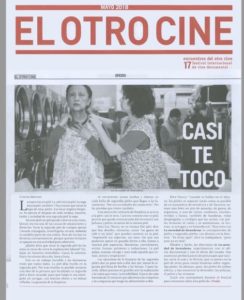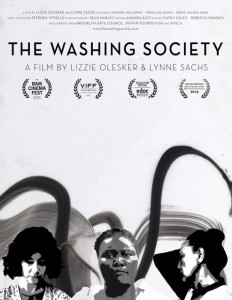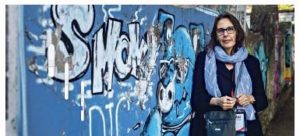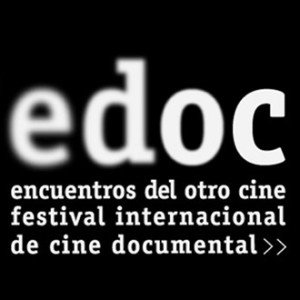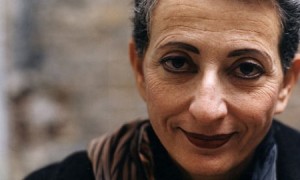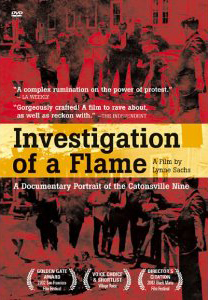El Otro Cine: “I Nearly Touch You”
I Nearly Touch You
By Cristina Mancero
Reprinted from the journal El Otro Cine, published by
Encuentros del Otro Cine, Quito, Ecuador
March 2018
Hand touches skin. Skin touches skin. Clothing, too, touches skin. And there are still other hands that touch the clothing that touches the skin of others. This particular touch involves cleaning. It eradicates every residue, stain, odor and variety of dirt that attaches to that second skin we call clothing.
The touch of skin upon skin can become something routine. Perhaps that’s one of the reasons for breakups and divorces. Touching the second skins of foreign bodies, washing them, rinsing them, spinning them, drying them, folding them is also part of a routine. But divorce doesn’t necessarily follow because the ones carrying out this particular routine depend on it for their survival.
Who would suggest that touching the second skin of others is exploitation? Working long hours. Earning minimum wage. Doing the same job hour after hour, day after day.
It’s an invisible job and the ghosts are all around us. The skin leaves traces and by those traces it is possible to form a picture of the person who quietly dropped off her second skin so that it could later be delivered, sweet smelling and wrinkle-free, in a sealed bag. Guaranteed clean.
Inside every bag of second skins that arrives at the Laundromat are countless traces. “By their impurities ye shall know them.” By their garments, also.
This cleanliness routine comes close to the skin: I nearly touch you. I nearly connect with your skin, but in the end all that remains of our encounter is lint, dust, a few flakes of that same dry skin.
Jean-Luc Nancy, in his essay “Essential Skin,” says that there are little things, minutiae like “a coffee bean or chiffon” that can get under our skins, “their appearance making an impression on us. Without even realizing it, roughness, softness, jerking, striations, vapors, urges, and murkiness all enter into our skin. The skin feels, handles, gathers, and deals with everything we see, hear, breathe.”
Those who carry out the cleaning of second skins take this one step further, they make things happen: they take the second skins full of traces and wipe them clean. And in order to do that, they must stand guard against the exploitation and monotony that kill. Invisibility. The weight of each quarter that feeds the machines and the machines that will, in turn, feed them.
“When it’s grasped,” writes Nancy, “skin is as dissociated as it possibly can be from its nature as a sort of envelope or boundary: instead it has the appearance of dough, paste, or mortar, of ribbons, laces, straps, bands, or liana, or of banners, and sails that are unfurled, along with the rigging used to haul them down. Skin soars and is heaped up; it is lustrous, creased, and moist.” This is what happens with The Washing Society: it juxtaposes skins and second skins, their grasping at the boundaries. “I’m here,” says one of the washerwomen, “but this is not who I am.”
Olesker and Sachs, the film’s directors, experiment with the craft of documentary and the craft of laundering. Their characters go back and forth between the real and the fictitious, putting themselves in other people’s skins in order to tell stories of second skins. The skins of each craft grasps the other and together reveal the nakedness, the lint, the dust, the flakes.
Translation: Philip Kay
Original Spanish version:
Casi te toco
La mano toca la piel. La piel toca la piel. La ropa toca la piel, también. Y hay manos que tocan la ropa de otras pieles. Ese tocar implica limpieza. Se ejecuta el despojo de todo residuo, mancha, hedor y suciedad de una segunda piel: la ropa.
Tocarse piel con piel puede volverse una rutina. Quizás sea esa una de las causas de separaciones y divorcios. Tocar la segunda piel de cuerpos ajenos y lavarla, enjuagarla, centrifugarla, secarla, doblarla es también parte de una rutina. Pero ahí no hay un divorcio, necesariamente, porque quienes lo hacen se apoyan en esa actividad para sobrevivir.
¿Quién diría que tocar la segunda piel de los otros es tocar de cerca la explotación laboral? Trabajar en horarios extendidos. Ganar lo mínimo. Hacer lo mismo día a día, hora a hora.
Este es un trabajo invisible y los fantasmas están por todos lados. La piel deja huella en la segunda piel. Por esas huellas es posible armarse una idea de la persona que ha dejado su segunda piel a buen recaudo, para que luego le sea entregada sin arrugas, con buenos olores y en bolsas selladas. La garantía de la limpieza.
Se encuentran tantas huellas y objetos en cada bolsa de segundas pieles que llegan a las lavanderías. “Por sus suciedades los conoceréis”. Por las prendas que visten también.
Esta ejecución rutinaria de limpieza se acerca a la piel: casi te toco. Casi me conecto con tu piel, pero lo que queda como prueba del encuentro son pelusas y polvo; escamas de la misma piel.
Jean-Luc Nancy, en su ensayo Dar piel, dice que hay detalles, minucias, como “un grano de café o un jirón” que pueden meterse en la piel, “imponerle sus aspectos, sus aires. Sin que nos podamos poner en guardia frente a ello, entran a nuestra piel asperezas, blanduras, convulsiones, estrías, humos, pulsiones y turbaciones. La piel palpa, maneja, recoge y trata todo aquello que vemos, oímos y respiramos”.
Las ejecutoras de la limpieza de las segundas pieles dan un paso más a allá, dan pie: toman la segunda piel llena de huellas y las borran. Y para hacerlo, deben ponerse en guardia ante la explotación y la rutina que mata. La invisibilidad. El peso de cada moneda de 25 centavos que alimenta a las máquinas y las máquinas que luego las alimentarán a ellas.
Dice Nancy: “cuando se hallan en el abrazo, las pieles se separan tanto como es posible de su naturaleza de envoltura y de frontera; toman más bien un aire de amasijo, de goma, de argamasa, o aun de cintas, cordones, cinchos, vendas y lianas, también de banderas, velas desplegadas y cordajes que las arrían. Las pieles levantan el vuelo y se amontonan, se lustran, se arrugan y se humedecen”. Pasa esto con La sociedad del lavado: la yuxtaposición de pieles y segundas pieles, sus abrazos en la frontera. “Yo estoy aquí”, dice la trabajadora, “pero esto no es mío”.
Olesker y Sachs, las directoras de La sociedad del lavado, experimentan con el oficio documental y con el oficio del lavado. Nos muestran performances de personajes que oscilan entre lo real y lo ficticio; que se ponen en la piel de otros para contar historias sobre segundas pieles. Se abrazan, pues, las pieles de ambos oficios, y nos muestran la desnudez, las pelusas, el polvo y las escamas.

